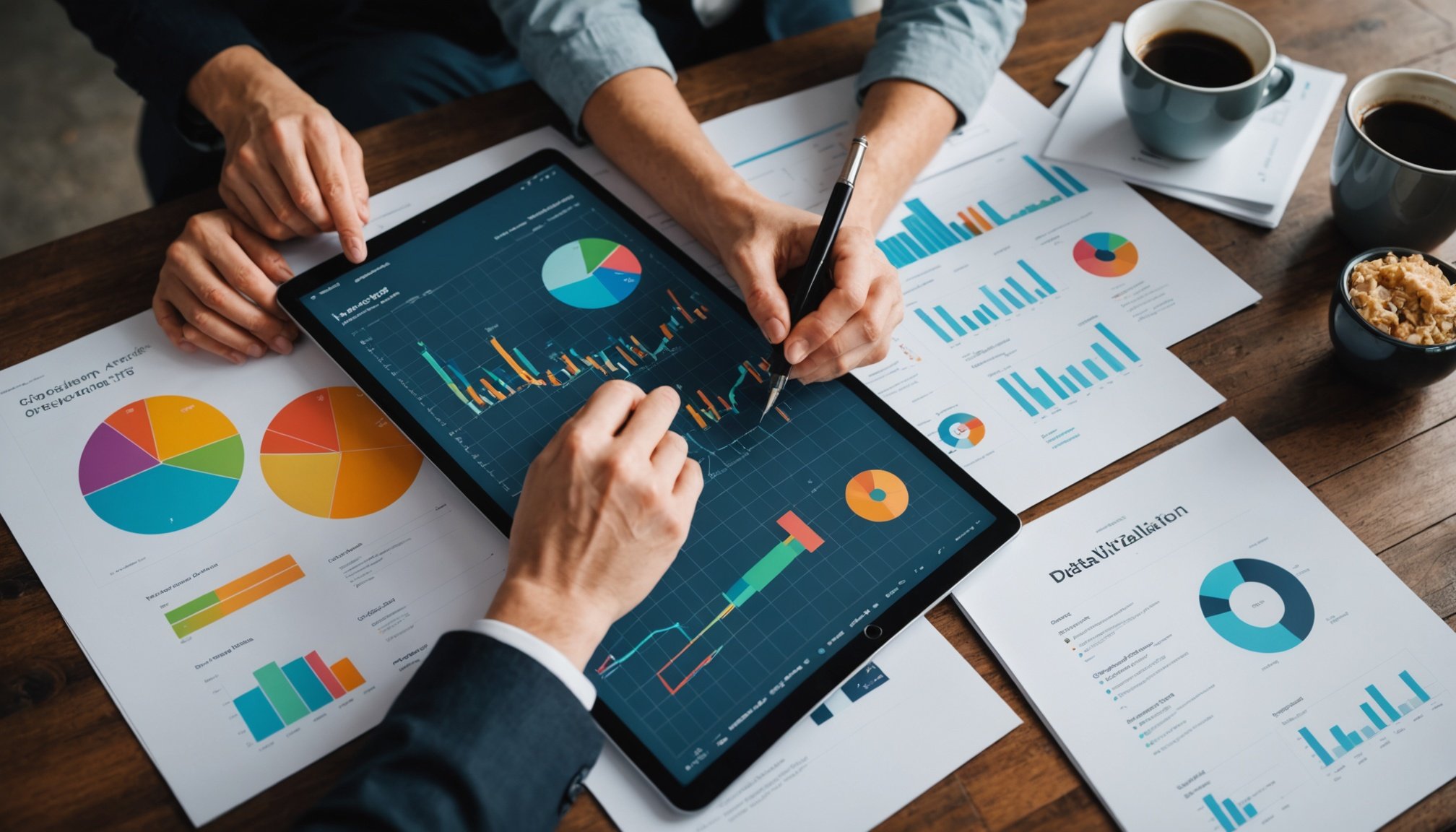Unlocking the Power of Data Visualization Tools: Enhancing the Impact of Marketing Insights
In the era of big data, businesses are inundated with vast amounts of information that, if harnessed correctly, can drive unprecedented growth and innovation. At the heart of this data revolution lies the powerful tool of data visualization. This article will delve into the world of data visualization, exploring how these tools can transform marketing insights, facilitate informed decision-making, and propel businesses forward.
The Importance of Data Visualization in Marketing
Data visualization is more than just a method for presenting data; it is a crucial tool for uncovering insights, solving problems, and making informed decisions. In the context of marketing, data visualization can make complex data sets actionable, enhancing communication, efficiency, and strategic decision-making.
Also read : Leveraging social proof: how brands can build customer trust through strategic marketing
Understanding Big Data
When dealing with large data sets, patterns and trends are easier to spot using visualization techniques. For instance, line graphs or heat maps can quickly reveal customer behavior patterns, market trends, and performance metrics that might be obscured in raw data[5].
Improving Communication
Data visualization tools provide visual formats that simplify data points, enabling effective communication between teams and stakeholders. Since 65% of people prefer learning visually, and the human brain processes visuals 60,000 times faster than text, these tools are essential for rapid comprehension and collaboration[5].
Have you seen this : Exploring gdpr’s impact on modern digital marketing strategies
Facilitating Decision-Making
Data visualization helps business professionals identify patterns quickly, enabling faster and more confident decision-making. Presentations with visual aids are 43% more effective at persuading audiences than those relying on text alone, highlighting the role of visuals in driving consensus and encouraging informed action[5].
Advanced Data Visualization Techniques
Modern data visualization tools go beyond traditional charts and graphs, offering nuanced and detailed perspectives on complex data sets.
Treemaps
Treemaps display hierarchical data using nested rectangles, making them ideal for visualizing parts of a whole within a complex data set. Each rectangle represents a category, with its size corresponding to a specific metric. Treemaps are particularly useful for visualizing market share among competitors or the distribution of marketing budgets across different channels[2].
- Hierarchical data representation: Treemaps efficiently display hierarchical information, making it easy to see how individual components contribute to the whole.
- Space utilization: They use space efficiently, providing a compact visualization that can display large amounts of data in a small area.
- Quick insights: Treemaps allow for quick identification of dominant categories and their relative sizes, facilitating immediate insights.
Sankey Diagrams
Sankey diagrams illustrate the flow of resources or data between different stages or categories. They are particularly useful for visualizing processes, traffic, or customer journeys. For example, marketers can use Sankey diagrams to analyze the flow of traffic through a website, tracing how customers navigate from one page to another and identifying where visitors drop off or where traffic bottlenecks occur[2].
- Flow representation: Sankey diagrams effectively show the movement of data or resources through a system, highlighting major transfers and losses.
- Complex process visualization: They can simplify the understanding of complex processes by providing a clear visual representation of how different elements interact.
Top Data Visualization Tools for Marketing
Choosing the right data visualization tool is crucial for unlocking the full potential of your marketing data. Here are some of the top tools available, each with its unique features and benefits.
Tableau
Tableau is a powerhouse for data visualization, helping marketers make sense of complex datasets. Its AI-driven tools like Explain Data and Ask Data let you uncover trends without being a data scientist. Tableau is ideal for creating stunning, interactive visualizations that impress stakeholders and integrate seamlessly with CRMs and data sources like Salesforce[1].
| Feature | Description |
|---|---|
| Interactive Dashboards | Visualize campaign performance in real-time |
| AI-Powered Insights | Identify patterns and anomalies effortlessly |
| Integration | Works seamlessly with CRMs and data sources like Salesforce |
Power BI
Power BI is another big name in the data visualization world. It integrates seamlessly with other Microsoft products like Excel, SharePoint, and Azure. Its affordable pricing and ease of use make it a go-to for many businesses. Power BI is known for its intuitive and accessible interface, strong integration with the Microsoft ecosystem, and customizable reports and dashboards[3][4].
| Feature | Description |
|---|---|
| Intuitive Interface | Easy to use even for non-technical users |
| Microsoft Ecosystem Integration | Works well with Excel, SharePoint, and Azure |
| Customizable Reports | Allows for tailored dashboards and reports |
Qlik Sense
Qlik Sense is a self-service business intelligence tool known for its associative data engine. This tool allows you to explore data freely, uncover hidden trends, and gain insights from multiple data sources in real-time. Qlik Sense is popular for its powerful data discovery and exploration capabilities, easy-to-use interface, and smart search and associative exploration features[3][4].
| Feature | Description |
|---|---|
| Associative Data Engine | Enables free exploration of data and uncovering of hidden trends |
| Easy-to-Use Interface | User-friendly interface for non-technical users |
| Smart Search and Exploration | Facilitates quick and intuitive data analysis |
Leveraging Insights for Targeted Marketing
After gathering insights from your dataset, you can use them to create more effective marketing strategies.
Demographic Segmentation
Use the gender and age breakdown to create personalized campaigns. For example, if your data shows that a particular age group is more interested in a specific product, you can tailor your marketing messages and offers to appeal to that demographic[1].
High-Value Customers
Offer exclusive rewards or VIP status to your top spenders. By identifying and rewarding your most valuable customers, you can increase loyalty and encourage repeat purchases.
Product Preferences
Promote products that customers in specific age groups or genders are most interested in. This targeted approach can significantly improve the effectiveness of your marketing campaigns.
Purchasing Frequency
Engage repeat buyers with tailored offers or loyalty programs. Understanding the purchasing frequency of your customers can help you design retention strategies that keep them coming back.
Enhancing User Interaction and Experience
Implementing advanced interactive features can make data visualizations more engaging and insightful.
Interactive Elements
Features such as hover details, clickable legends, and filters can significantly enhance the user experience. These elements allow users to explore data in greater depth, uncovering insights that static charts might miss. For instance, an interactive dashboard with filter options enables viewing data from different campaigns or time periods, providing a more comprehensive understanding of performance trends[2].
Responsive Design
Ensuring that visualizations are adaptable to different screen sizes and devices improves accessibility and usability. A responsive marketing dashboard can be accessed from desktops, tablets, and smartphones, ensuring that team members can review and act on data insights during meetings or on the go[2].
The Future of Data Visualization: AI, Machine Learning, and Predictive Analytics
The future of data visualization is heavily influenced by emerging technologies like AI, machine learning, and predictive analytics.
AI-Driven Tools
Advanced data visualization tools are incorporating AI to generate visualizations automatically based on the data set provided. For example, AI algorithms can recommend the best visualization method, such as scatter plots or bar charts, depending on the data points. This automation streamlines the analysis process, making it more efficient and insightful[5].
Predictive Visual Analytics
Machine learning models enable predictive visualizations by forecasting trends and displaying potential outcomes visually. This capability is invaluable for businesses seeking actionable insights for future strategies. For instance, a dashboard displaying projected sales growth based on past performance and market conditions can guide future marketing strategies[5].
Practical Insights and Actionable Advice
Here are some practical tips for leveraging data visualization tools in your marketing strategy:
-
Choose the Right Tool: Select a tool that aligns with your business needs, budget, and technical expertise. Whether you need a user-friendly interface like Power BI or the customization offered by D3.js, the right tool can make a significant difference[3][4].
-
Focus on Storytelling: Data visualization allows you to tell a compelling story through data. Use visualizations to convey complex information in a way that resonates with your audience, making it easier to communicate insights and drive action[3].
-
Ensure Interactivity: Implement interactive elements to enhance user engagement and insights. Interactive dashboards and responsive designs can make your data visualizations more accessible and useful across different devices and scenarios[2].
-
Leverage AI and Machine Learning: Utilize AI-driven tools and machine learning models to automate data analysis and generate predictive visualizations. These technologies can significantly enhance the efficiency and impact of your data-driven insights[5].
Data visualization is a powerful tool that can transform the way businesses approach marketing analytics. By leveraging advanced data visualization techniques, top-tier tools, and emerging technologies like AI and machine learning, marketers can uncover deeper insights, enhance communication, and make informed decisions. Whether you are segmenting your customer base, analyzing market trends, or predicting future performance, data visualization is the key to unlocking the full potential of your marketing data.
As Tableau puts it, “Interactive dashboards and AI-powered insights can help you uncover trends without being a data scientist.” This democratization of data analysis makes it possible for businesses of all sizes to make data-driven decisions, driving growth and innovation in the digital marketing landscape.
In the words of a marketing analyst, “Data visualization has changed the game for us. We can now see patterns and trends in real-time, which has significantly improved our decision-making process and campaign effectiveness.”
By embracing the power of data visualization, you can turn complex data into actionable insights, drive better marketing strategies, and stay ahead in the competitive market of 2025.


